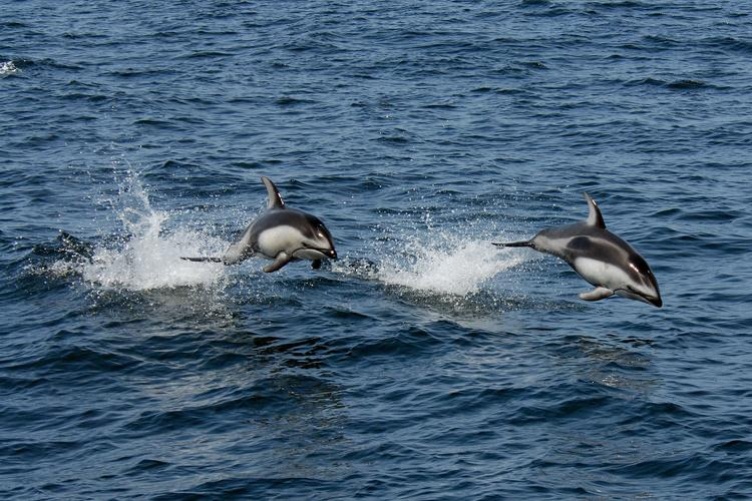
Pacific white-sided dolphins (above) have a call that sounds almost identical to that of the Risso's dolphins. Photo credit: NOAA Fisheries
Dolphins, like many ocean-going creatures, are on the move — warming ocean temperatures are pushing many of these marine mammals far north of their historic ranges. Now, a UNH-led breakthrough in underwater acoustic technology will help scientists to distinguish between similar-sounding cetacean calls as they expand their habitat due to climate change.
A recent study published in Nature focuses on two species of dolphins — the Pacific white-sided dolphin and the Risso’s dolphin — that have been heard in Alaska’s Bering and Chukchi seas in recent years, signifying their northward habitat expansion past the Aleutian archipelago. The vocalizations of these two species are nearly identical, making it difficult for both scientists and computer algorithms to tell them apart from one another and thus differentiate their movements.

Mahdi Al Badrawi, a research assistant professor in the UNH Center for Acoustics Research and Education and first author on the study, saw an opportunity to improve on the previous technologies. By pairing a detector (which filters out noise and identifies animal sounds) and an improved type of classifier (which matches the newly recorded vocalizations to a database of known animal sounds), researchers can now distinguish a Pacific white-sided dolphin from a Risso’s dolphin with just a single clicking sound made by the dolphins and recorded underwater — a crucial upgrade, Al Badrawi notes, because there may be only a few vocalizations recorded as the dolphins move into new territory.
“Monitoring marine mammals is vital for conservation efforts and climate change tracking,” he explains. “In addition, it’s likely that these two dolphin species will have an impact on the Arctic food web, and because they eat the same types of fish that humans do, fisheries managers will need more information about dolphin populations and habitat expansion to set sustainable limits on fish harvests.”
"Monitoring marine mammals is vital for conservation efforts and climate change tracking."
Al Badrawi’s interest in underwater acoustics began while he was a post-doctoral researcher at UNH in 2017, when he first started to explore this topic with colleagues. As part of this study, he developed a tool called the Variational Mode Decomposition (VMD), which enables the classifier to break down sound signals into more highly defined pieces to see all the fine-scale characteristics. The new technology he helped develop can be used to differentiate animals of similar acoustic characteristics, whether they live underwater or on land, he notes.
“I find it fascinating how the classification of these animals — being able to tell them apart from one another — can play an important role in our understanding of climate change and our efforts to mitigate those changes,” he adds.
This research was funded by the U.S. Office of Naval Research’s Marine Mammal and Biology Program.
The UNH Institute for the Study of Earth, Oceans, and Space (EOS) is UNH's largest research enterprise, comprising six centers with a focus on interdisciplinary, high-impact research on Earth and climate systems, space science, the marine environment, seafloor mapping and environmental acoustics. With approximately 100 principal investigators managing more than 400 individual grant awards, and with annual expenditures exceeding $45 million, EOS fosters an intellectual and scientific environment that advances visionary scholarship and leadership in world-class and graduate education.
-
Written By:
Rebecca Irelan | Institute for the Study of Earth, Oceans, and Space | rebecca.irelan@unh.edu | 603-862-0990

















































